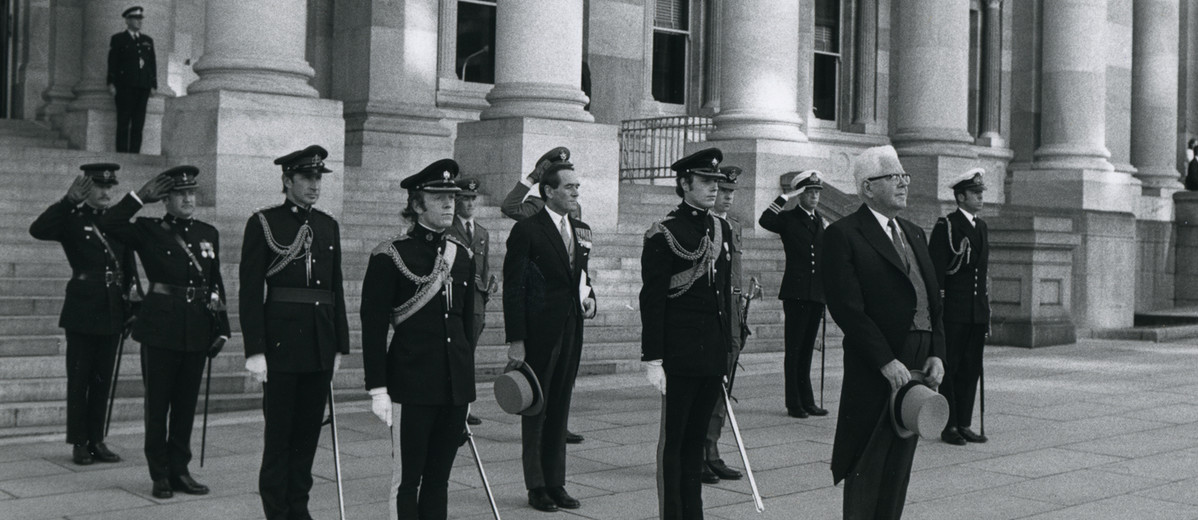State Governor from 1971-1976, Sir Mark Oliphant was a man of conscience, not content with the purely ceremonial role of the vice-regal position. His appointment was criticized by opposition M.P.s as an attempt by the Dunstan administration to discredit and eliminate the traditional role of the Governor but, ironically, he is now credited with reinvigorating the governorship. His forthright, commonsense opinions appealed to middle Australia and often challenged those in authority. No stranger to controversy, his frequent forays into the newspapers earned him the sobriquet of ‘the people’s Governor’ and this period of his life tends to overshadow his scientific achievements.
He was born Marcus Lawrence Elwin Oliphant, in Adelaide, South Australia, on 8th October 1901, the son of civil servant Harold George Oliphant and his wife Beatrice Edith Fanny (née Tucker), a schoolteacher. He was educated at Goodwood Primary School and at Unley and Adelaide High Schools. After matriculating, he attempted to support himself as a part-time student at the University of Adelaide. His remarkable experimental skills were recognized by Professor Kerr Grant and he was offered a cadetship in the physics department, which provided him with free tuition in return for his maintaining the laboratory. He completed his Bachelor of Science in 1921, with honours the following year.
Oliphant became full-time assistant in the physics department and published his first scientific papers in Adelaide, but the frontiers of physics were overseas. On 23rd May 1925 he married Rosa Wilbraham and in the same year he won an Exhibition Scholarship, which took him to the Cavendish Laboratories in Cambridge. This famous research facility, under the directorship of Ernest Rutherford, was unlocking the secrets of the atom and producing Nobel Laureates. Oliphant’s technical skills were ideally suited to the construction of the equipment required to accelerate and smash apart atoms.
Oliphant remained at the forefront of nuclear physics for the next twenty-five years. In 1937 he was made a Fellow of the Royal Society and, on Rutherford’s recommendation, appointed to the Poynting chair of physics in Birmingham. Here he continued his atom-smashing investigations. The potential for an atomic bomb was apparent to the researchers long before World War II and Oliphant was recruited into the Manhattan project in late 1943. His experimental expertise was crucial in producing the enriched uranium for the first bombs. The military use of nuclear power always distressed him. Initially he was hopeful that the peaceful use of nuclear energy might balance the scales but in later years he came to believe that the risks outweighed the benefits. He became an outspoken anti-nuclear campaigner during the 1970s when the French conducted atomic bomb tests in the Pacific Ocean.
Oliphant was consulted by the Curtin government (1941-45) on nuclear issues and was asked to join the Australian delegation to the United Nations treaty discussions. The Federal Government recruited him to help establish the Australian National University and in 1950 he returned to Australia to become its first Director of Physical Sciences. Most of his time was spent establishing a new facility in Canberra and navigating the bureaucratic seas of federal politics. He championed Australian science at a time when it was generally ignored and poorly funded. A founding member of the Australian Academy of Science, he initially refused a knighthood but accepted it in 1959. He retired in 1966, staying on as an Honorary Research Fellow at the A.N.U. until appointed Governor of South Australia in 1971. In 1977 he was made a Companion of the Order of Australia.
Sir Mark Oliphant died on 14th July 2000 and was cremated in Canberra. A bronze bust of him, by John Dowie, is situated in the Prince Henry Gardens on North Terrace.
Cockburn, S. and D. Ellyard, Oliphant (Adelaide: Axiom, 1981).




Add your comment